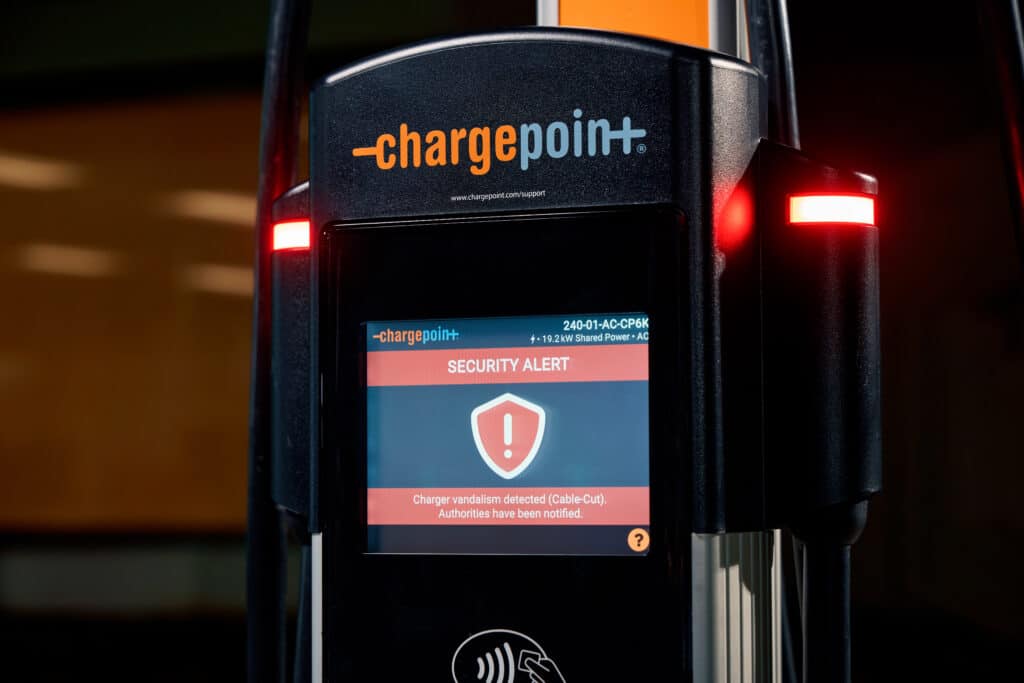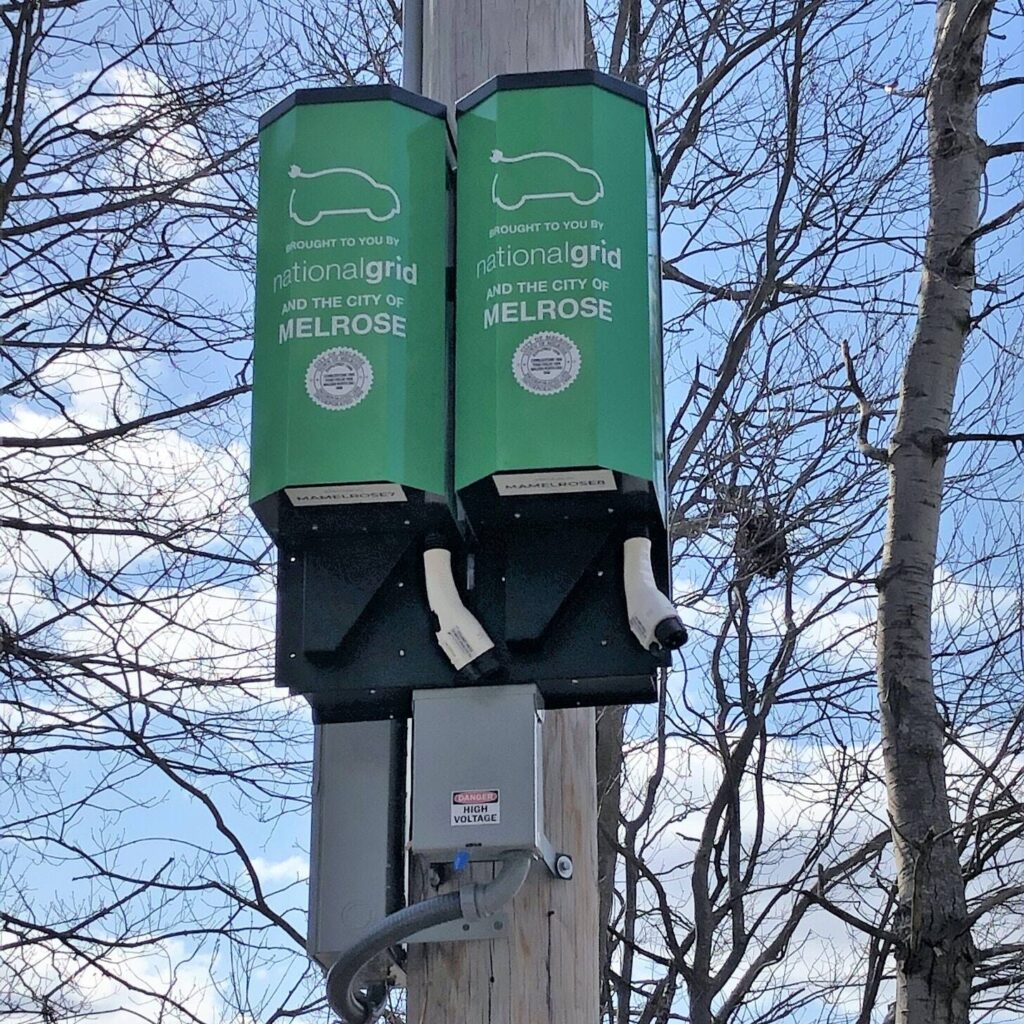Innovators Offer New Solutions for EV Charger Cable Theft
EV charging cable theft has become a growing concern as the popularity of electric vehicles continues to rise. Since many public charging stations use fixed cables, these cables are often left unattended when not in use, making them an easy target for theft.
The value of copper has been notably increasing over recent years and some criminals mistakenly believe the copper in the rapid charging cables, attached to public charging stations, is worth stealing.
Several innovative companies are leading the charge against EV charger cable theft, along with solving other problems, such as the incredibly important effort to install more charging for multifamily dwellers, through curbside charging.
ChargePoint Unveils Cut-resistant Charging Cable, Sophisticated Alarm System
ChargePoint, a leading provider of electric vehicle (EV) charging solutions, has unveiled two new innovations designed to address the growing issue of charger vandalism. The first is a cut-resistant charging cable, which significantly enhances the durability and security of the cables used at charging stations, making them more resistant to damage or tampering.
Additionally, ChargePoint has introduced ChargePoint® Protect, a sophisticated alarm system designed to improve the security of charging stations. This system alerts users and operators if there is any potential vandalism or unauthorized tampering, further strengthening the protection of these critical assets.

The company revealed the first-ever cut-resistant charging cable, designed specifically to deter cable theft. This innovation comes from ChargePoint’s over fifteen years of experience in product design and charging station development, aimed at tackling the significant challenges of cable theft and vandalism. The new cables are made from advanced cut-resistant materials that make them much more difficult for vandals to sever, while still maintaining the flexibility needed for drivers to comfortably use them.
ChargePoint plans to make these cut-resistant cables available for all its commercial and fleet charging stations, and it will selectively license the cable design to other charging station manufacturers, aiming to lead the industry in combating these issues. ChargePoint expects the cables to be available for licensing by mid-2025.
In addition to the cut-resistant cables, ChargePoint also launched ChargePoint Protect, a new charger alarm system designed to enhance the security of charging stations. This system integrates with the existing components of ChargePoint chargers, such as speakers, screens, and lighting, to create an effective alarm system capable of detecting cable tampering in real time. When tampering is detected, the system automatically activates the alarm to deter vandals.
ChargePoint Protect can be activated on select charging station models at no extra cost to current customers through a cloud-based software update. The system also enables station owners to receive SMS or email notifications if an alarm is triggered, providing faster alerts and enabling a quicker response, including law enforcement intervention. ChargePoint expects ChargePoint Protect to be available beginning this month.
“ChargePoint Protect and our cut-resistant cables demonstrate our relentless dedication to offering a dependable charging network. We do not view ourselves as victims of vandalism, but rather responsible for solving it, not only for our customers but for the industry,” said Rick Wilmer, CEO of ChargePoint. “We are sharing the technology to combat vandalism in the most aggressive way possible with the aim to eliminate charger reliability as a hinderance to EV adoption.”
For more information, please visit: www.chargepoint.com. To inquire about licensing the cut-resistant cable technology, please contact: techlicensing@chargepoint.com.
Detachable EV Charging Cables Solve the Problem Also
As cable theft typically happens at night, and when EVs are not charging, a more elegant solution to the problem is detachable EV charging cables.
itselectric, a Brooklyn-based electric vehicle (EV) charging network, announced in March 2024 a major breakthrough in EV charging technology with the introduction of the “Brooklyn-718” charger. This innovative charger is the first-ever EV charger with a detachable cable to be certified under UL Standards, marking a significant advancement in the North American market. Designed to meet the growing demand for curbside charging in cities across the United States, the detachable cable model provides a more efficient and durable solution for public EV charging.
In the EU and UK, detachable cable EV chargers have become the norm, with drivers stowing the cable in their vehicles when not in use. This design offers several benefits: it ensures that the charging unit remains compact and durable while also minimizing downtime caused by damaged or vandalized cables. Many U.S. drivers have experienced frustration with limited access to public charging, particularly when cables become faulty or unusable. The detachable cable model addresses this issue, as a damaged cable does not result in an inoperative charger.
Furthermore, this design allows itselectric to future-proof its charging infrastructure as the automotive industry transitions from the J1772 standard to the J3400 (commonly known as the NACS connector). Unlike traditional chargers with fixed cables, itselectric’s chargers are adaptable, with drivers provided a cable that suits their vehicle’s connector, making the chargers “evergreen.”
it’s electric celebrates this achievement alongside its engineering and manufacturing partner, Gyre9, a product development company based in Southbury, Connecticut. Gyre9 played a key role in both the mechanical design and the certification process, collaborating with TÜV Rhineland’s laboratories in New England and California.
“it’s electric is the only North American company to offer a detachable cable solution. As we like to say, not weird – just European! Given that cities, property managers, and (other) charging companies are running in circles to solve the issue of cut cables when chargers are not in use. We believe the simplest solution is the answer. Just remove the cable when a car is not charging,” said Tiya Gordon, Co-Founder/COO, it’s electric.
Nathan King, it’s electric Co-Founder, explains the company’s innovative systems in the video below by Coast-to-Coast.
Pole-mounted Level 2 Chargers Solve Theft Problems and Multiple Other Problems
EVSE has introduced an innovative approach to curbside EV charging by mounting charging stations on existing utility or lighting poles, which represents a significant shift in the way charging infrastructure is deployed. By leveraging existing infrastructure, such as utility poles, the company has been able to drastically reduce both the costs and time associated with installing EV chargers. The charging cords are secured up high, out of the reach of thieves.
This new method can cut installation expenses by up to 70%, making it far more affordable and efficient than traditional charging station setups. The integration of charging stations with existing utility poles offers a smart, cost-effective solution for expanding EV networks, especially in dense, underserved urban areas where traditional installations might be impractical.
EVSE and AmpUp partnered with National Grid to install pole-mounted chargers in Melrose, Massachusetts, home to the first pole-mounted EV chargers on the East Coast.

The benefits of mounting chargers on utility or light poles are clear. Positioned approximately 10 feet above the ground, these chargers are less vulnerable to vandalism, vehicular damage, or environmental hazards that often impact ground-level units. This elevated positioning enhances the longevity and reliability of the charging stations, providing a safer and more secure option for both drivers and infrastructure owners.
One of EVSE’s key innovations, the 3704 Light/Utility Pole EV Charger, incorporates features that set it apart in the EV charging landscape. This charger includes Automated Cable Retraction, which adheres to both ADA and OSHA standards. The 25-foot cable automatically descends when a driver begins charging and retracts once unplugged, ensuring a clean, efficient process while keeping the cable safe from theft and damage when not in use.
The pole-mounted Level 2 chargers are particularly well-suited for high-density urban environments, where space for traditional, bulkier charging stations is limited. With the ability to provide up to 35 miles of range per hour of charging, these chargers are ideal for drivers who need to park their vehicles for extended periods, such as when shopping, dining, or staying overnight near apartments or condos. This new paradigm in charging infrastructure is a promising step toward addressing the growing demand for accessible, convenient EV charging in busy cities.

Electric Vehicle Marketing Consultant, Writer and Editor. Publisher EVinfo.net.
Services